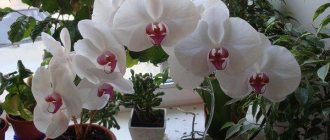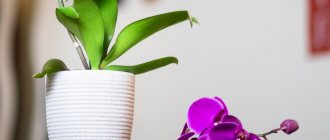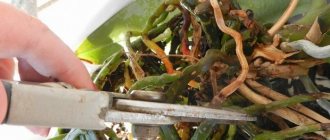Features of flowering
The orchid begins to bloom at the age of 1.5-2 years, when 5-8 leaves have formed on the stem.
Flowering too early is undesirable: it will be difficult for the plant to regain its strength and it may die.
An orchid can bloom profusely for up to 7 years. After this, flowering is reduced to 1-2 months, and it cannot be extended despite careful care. In this case, plant rejuvenation is required.
There are several phases in the development of an orchid:
- The growing season begins with the formation of a new shoot - leaves and root systems grow.
- During the dormant period, new buds and peduncles are formed.
- During the flowering phase, the plant expends energy.
- This is followed by a period of rest, recuperation and accumulation of energy for new flowering.
Typically the flowering phase lasts about three months and begins in the fall. With proper maintenance, a strong plant can produce flowering shoots even in the spring, having time to replenish its strength. Peduncles can appear three times a year. With quality care, orchids can bloom for more than 8 months.
Changing the color of the growing point of monopodial orchids
The base of the top leaf, where growth continues, is the growing point of the orchid. The cause of yellowing of the growth point is:
- Suboptimal growing conditions;
- Failure to comply with the watering regime;
- Infectious diseases.
Important! Orchid roots do not tolerate stagnant water, so the remaining moisture from the trays must be drained.
If the damage to the growing point is too severe, the orchid will stop growing upward and will most likely die.
If the growing point is damaged, the orchid dies.
If, thanks to good immunity, the orchid survives, it can form a baby on the stem or flowering arrow and continue to grow.
What can speed up the process of buds withering?
A reduction in flowering time and rapid natural wilting of buds may depend on the age of the orchid. Older plants will have buds that quickly wither. In plants of active age, accelerated wilting of buds can occur when:
- Moving a flower pot from its usual place.
- Insufficient lighting.
- Sudden temperature fluctuations.
- Close location to heating radiators in winter.
- Violation of the watering schedule.
- Excessive or low air humidity.
- Pollination of flowers by insects flying in from the street.
- Exposure to ethylene emanating from ripe bananas, apples lying next to an orchid.
When is shedding natural and when is it not?
The flowering of an orchid begins with the smooth and slow opening of a bud located closer to the end of the peduncle. First, the side and upper petals unfold, and then the lip and the entire flower open. This happens within 24 hours.
The flower lasts 2-3 days. Then it withers, dies and falls off. This is a natural process. The flower that opens first falls first. With a sudden drop, the flowers wither and fall chaotically, regardless of the beginning of the opening of the buds.
Important! To track the development of flowers, when purchasing, it is better to choose plants with barely opened buds.
Why does this happen: main reasons
When an orchid quickly sheds buds and flowers, you should wonder why this is happening. It is necessary to analyze the system of caring for the plant in order to help it and protect it from death. Common reasons:
Temperature violation
Orchids are sensitive to temperature changes and drop flowers when:
- Hypothermia. Inflorescences die at temperatures below +5°C. A cold window sill in winter can cause the buds to drop.
- Overheating from direct sunlight or radiators in winter. This injures the roots and dries out the soil.
- Sudden changes in temperature. A decrease of more than 4°C is a signal of the end of the flowering period.
- Drafts and excessive ventilation.
Insufficient lighting
Orchids produce buds as daylight increases. The development of buds requires more and more light. If there is not enough sunlight, the buds will fall off.
The orchid grows best on light eastern windowsills.
On southern windowsills, flowers are shaded from the direct rays of the sun. Orchids also grow on northern windows, but they require additional lighting. In cloudy winter weather, orchids are illuminated with fluorescent lamps for up to 10-12 hours of daylight.
Low air humidity
The most comfortable air humidity for a blooming orchid is at least 60%. When the humidity drops to 50%, not only the buds begin to drop, but also a general deterioration in the condition of the plant.
Humidity is increased in one of the following ways:
- Place open bowls of water next to the plant.
- In the morning, spray the leaves and roots with water.
- Set up a small fountain or automated humidifier.
- Place the pot with the orchid on a tray with damp expanded clay.
When placing the pot on a tray with expanded clay, the bottom should not touch the water to prevent rotting of the roots from waterlogging.
Improper watering
Overdrying and waterlogging the soil is detrimental to the orchid. The soil in the pot should be slightly moist, but not wet.
Presence of diseases and pests
The orchid may appear:
- Gray rot - gray spots form on the lower part of the plant. The disease can be caused by waterlogging of the soil, hypothermia or an overdose of nitrogen fertilizers.
- Root rot - manifested by browning of leaves, softening of roots, which no longer provide the plant with moisture and nutrition. They are treated with the drugs “Fundazol” and “Topsin”. Treat 2-3 times every 20 days.
- Mealybug - the foliage turns yellow, a white fluffy coating forms in the axils. The scale insects are removed with a soap solution, and then the plant is sprayed with an insecticide.
What to do if the orchid's stem dries out?
Let's find out below what to do if the orchid has faded and the stem has dried out.
From the top of the head
If for some reason the growing point of an orchid plant like Cattleya dies, then you need to:
- Cut off the dying pseudobulb;
- And treat for fungal infections.
If you create the right conditions for it, it will continue to grow.
It’s worse when the only growing point of an orchid species like Phalaenopsis dies. Here it is necessary to take drastic measures to save the plant. If this is fast-growing rot, then the plant has virtually no chance.
If the loss of a growing point is a consequence of drying out or mechanical injury, then you can help the orchid like this:
- The dried stem is cut back to a healthy living place;
- And they are treated with a fungicide against fungal diseases and wood ash.
For these reasons, the stem from the crown of the orchid dries.
Further care for such an injured bush should follow all the rules
You need to pay attention to the following care parameters:
- Watering;
- Lighting;
- Feeding with preparations for orchid plants with a higher proportion of nitrogen;
- Room temperature.
After a long time, up to six months, the flower will release lateral children. They are planted only when they reach normal size. That is, the roots will be up to 5 cm long and there will be a rosette of 2-3 leaves.
IMPORTANT! It is better to plan the transplant for spring, this way the new orchid babies will have a better chance of survival.
After flowering
Many gardeners observe that after flowering the orchid’s trunk dries out. Only on some it dries out completely, on others only partially. What to do with such a peduncle?
Causes
It can dry out for 2 reasons:
- Natural process;
- Improper care of the plant.
In the first case, after flowering, part of the old stem may begin to dry, and it changes the light. If you cut it to a healthy waiting bud, the plant will continue its growth after a certain time, raising children on the remaining trunk.
Signs of improper care when the trunk dries out:
- Excess or lack of moisture;
- Excessive lighting;
- Fungus or harmful insects.
If the peduncle was released by the plant from the growing point, this will serve as an impetus for the stem to dry out.
Treatment measures
If this plant has pseudobulbs, then they are not removed even if they partially dry out, if there are still unflowered peduncles on it. If it is Phalaenopsis and the flower arrow has dried out after flowering, then it is removed completely or partially. It depends on the wishes of the grower and on how dry the arrow is.
If completely, then remove the dried peduncle completely. And if the gardener wants to continue the flowering of his orchid and the peduncle has not yet dried out completely, then they cut it to a living place 2 cm above the waiting bud and wait for the flowering to continue.
After flowering, the dried stem of the orchid is cut off.
If it is the stem that really dries, then it is cut with pruning shears, which are first sterilized in alcohol. They establish a maintenance regime and wait for the children to appear.
IMPORTANT! After pruning with pruning shears, treat the cut with wood ash.
Step-by-step instructions: what to do to save the plant?
To save the plant, you need to know what to do next with the orchid if all the flowers and buds have fallen off.
With blossoming flowers
- Isolate the plant from other potted crops.
- Carefully examine the leaves, axils, and root areas. If signs of disease or pests are detected, treat.
- Provide comfortable temperature conditions: 20-24°C during the day and 15-18°C at night.
- Increase air humidity if it is insufficient.
- Maintain soil moisture, avoiding overdrying or waterlogging.
- Avoid drafts.
With unopened buds
- Isolate the plant.
- Conduct a thorough inspection of all parts of the plant. If pests or signs of disease are detected, treat the orchid.
- If the pot has been moved, return it to its original place in the same position.
- If there is a lack of light, equip additional lighting with a fluorescent lamp.
- Analyze the watering schedule and adjust in cases of dehydration or overflow of the substrate.
- Provide plant nutrition, paying attention to phosphorus-potassium ingredients.
- Check the temperature.
- If the air is extremely dry, provide humidification.
In what cases can you not help?
As mentioned earlier, there are some reasons why a plant does not want to bloom and drops its buds. Each of them is a stressful situation. Some gardeners are wondering in what cases it is possible to save the remaining buds of a plant, and in what cases it is necessary to wait for new shoots. Let's look at some situations in which buds cannot be restored.
- If an orchid is frozen and has a cold burn, it will need a lot of time to recover. First, the petals of orchid flowers suffer from this injury, as they are extremely delicate. In this case, it is impossible to save the buds; you should wait for the next flowering period.
- You cannot help a plant whose growing conditions have changed dramatically. For example, an orchid was grown in a greenhouse and then taken home. In order for the flower to get used to it and recover from stress, a long adaptation is needed. It is necessary to wait for the restructuring of the internal processes of the orchid.
- If the flowers begin to fade, it means the plant is old and this is normal. It is useless to help the orchid in any way in this case.
- If unopened buds fall off after the roots die, the root system should be restored. Peduncles need to be removed.
The use of folk and chemical remedies for prevention
To extend the flowering period, gardeners use home remedies.
Attention! All folk fertilizers are used in solutions of low concentration. Their shelf life is less than a week.
Banana peel infusion
Banana peel contains substances useful for the formation of flower stalks.
Fertilizer preparation:
- The dried peel of one banana is crushed.
- Pour the mixture with one liter of warm water and leave for 2-3 days.
- The mixture is filtered and diluted with settled warm water in a ratio of 1:2.
- The orchid is carefully watered with the resulting infusion.
Onion peel decoction
Onion fertilizer stimulates the formation and growth of flower ovaries.
Onion fertilizer is prepared:
- The peel of one onion is poured with a glass of water.
- Boil for 10 minutes over low heat.
- Leave for 1-2 hours, filter.
- The flowers are watered with a decoction diluted with water to a light shade at room temperature.
Potato fertilizer
Potato infusion stimulates the formation of buds and the growth of the root system. Peelings from several small potatoes are poured with boiling water, left for half an hour, and filtered. The resulting mixture is watered at a temperature of 35°C.
To feed orchids and extend flowering time, flower growers recommend using the following preparations:
- "Greenworld" - for root feeding and spraying.
- "Bona Forte" is a complex fertilizer that stimulates re-blooming.
- “Kemira-lux” is the most popular among flower growers.
The fertilizing of orchids provides the necessary nutrients not only to the flower stalks, but also to the entire plant, giving it vitality and strengthening the immune system. A strong, healthy plant does not shed flowers and buds.
Strict adherence to all rules for caring for an orchid helps prevent the dropping of buds and flowers. A healthy plant in comfortable conditions will bloom long and profusely, delighting everyone with its unusual outfit.
Flower processing options
https://www.youtube.com/watch?v=lwF-knKtMKc
One of the main reasons that an orchid can shed unopened buds is various diseases that appear as spots and bumps on the leaves: they can turn yellow and dry out. It is possible to combat them by treating flowers to prevent the development of pathologies and the proliferation of parasites on them.
Illumination of orchids with lamps
There are many types of pest treatment products on sale, both special chemicals (including numerous fungicides against fungal infections) and biological products and organic compounds. In addition, you can use centuries-old folk floriculture experience.
Chemicals
These are means of rapid and very effective response. They are divided into 4 hazard classes, they must be used strictly for their intended purpose and be sure to follow the dosage, otherwise you can harm both yourself and your green pet. The most popular among orchid lovers are such preparations as:
- "Fitoverm";
- "Inta-Vir";
- "Aktara";
- "Tanrek";
- "Confidor".
"Fitoverm" - a chemical preparation for treating orchids
The fungicide “Fitosporin” works well against fungal infections of orchids, which can also be used for prevention during plant replanting and subsequent pruning.
Along with chemical agents, biological flower protection products are produced. Plants do not accumulate them, and pests do not develop resistance. In addition, biological agents serve to increase immunity in orchids. Flower growers recommend fast-acting drugs:
- "Bikol";
- "Bitoxibacillin";
- "Lepidocide";
- "Verticillin";
- "Aversectin S";
- "Nemabact."
"Lepidotsid" - a biological product for treating flowers
If you don’t want to resort to chemistry, you can stick to folk remedies for treating flowers:
Soap solution: from 1 liter of water and 1 tbsp. spoons of liquid soap (or grated laundry soap), which is used to wipe the stems and foliage.
Additional Information. Regular dishwashing detergent will also work.
- Tobacco tincture: for 1 liter of water, take up to 40 grams of tobacco, ground into dust, leave for 24 hours, then strain and spray Phalaenopsis from a spray bottle.
- An infusion of onion, mashed and poured with 1 liter of boiling water, leave for 7 hours and apply to the leaves and stem. The course is 3-4 days, you should not get carried away, otherwise the plant may dry out.
- Dried citrus peels (100 grams) are poured with a liter of water and infused for a couple of days; the diseased plant is sprayed with this infusion every few hours for a week. Dry orange and tangerine peels can be used to cover the soil in a pot.
- The well-known hydrogen peroxide is used to treat orchids and other indoor plants in order to disinfect foliage and substrate from germs, mites and pests.
Advice
When using this drug, moderation and caution should be observed, otherwise the plant will begin to wither before our eyes.
Caring for a blooming orchid includes ensuring normal lighting, optimal watering, as well as suitable temperature conditions of 22-26 degrees. The need to moisten the flower is judged by the presence or absence of condensation on the walls of the pot. In this case, watering is carried out by placing the flower pot in a container of water.
The air around the orchid should also be moistened with a spray bottle; air humidity is recommended to be kept at 45-60 percent.
Note! If the flowering of Phalaenopsis meets the standards and pleases the eye, there is no need to move the flower to another place - this can cause stress for it, and the buds will begin to fall off. Feeding is a very important point in caring for this exotic flower.
Orchids should be fed during intensive growth and the release of flower stalks, using special fertilizers specifically designed for this type of plant. Soak the flower directly in the pot, add the concentrated mixture to the water and leave for 10-20 minutes, after which the excess liquid is drained. It is advisable to carry out this manipulation once every six months.
Feeding is a very important point in caring for this exotic flower. Orchids should be fed during intensive growth and the release of flower stalks, using special fertilizers specifically designed for this type of plant. Soak the flower directly in the pot, add the concentrated mixture to the water and leave for 10-20 minutes, after which the excess liquid is drained. It is advisable to carry out such manipulation once every six months.











